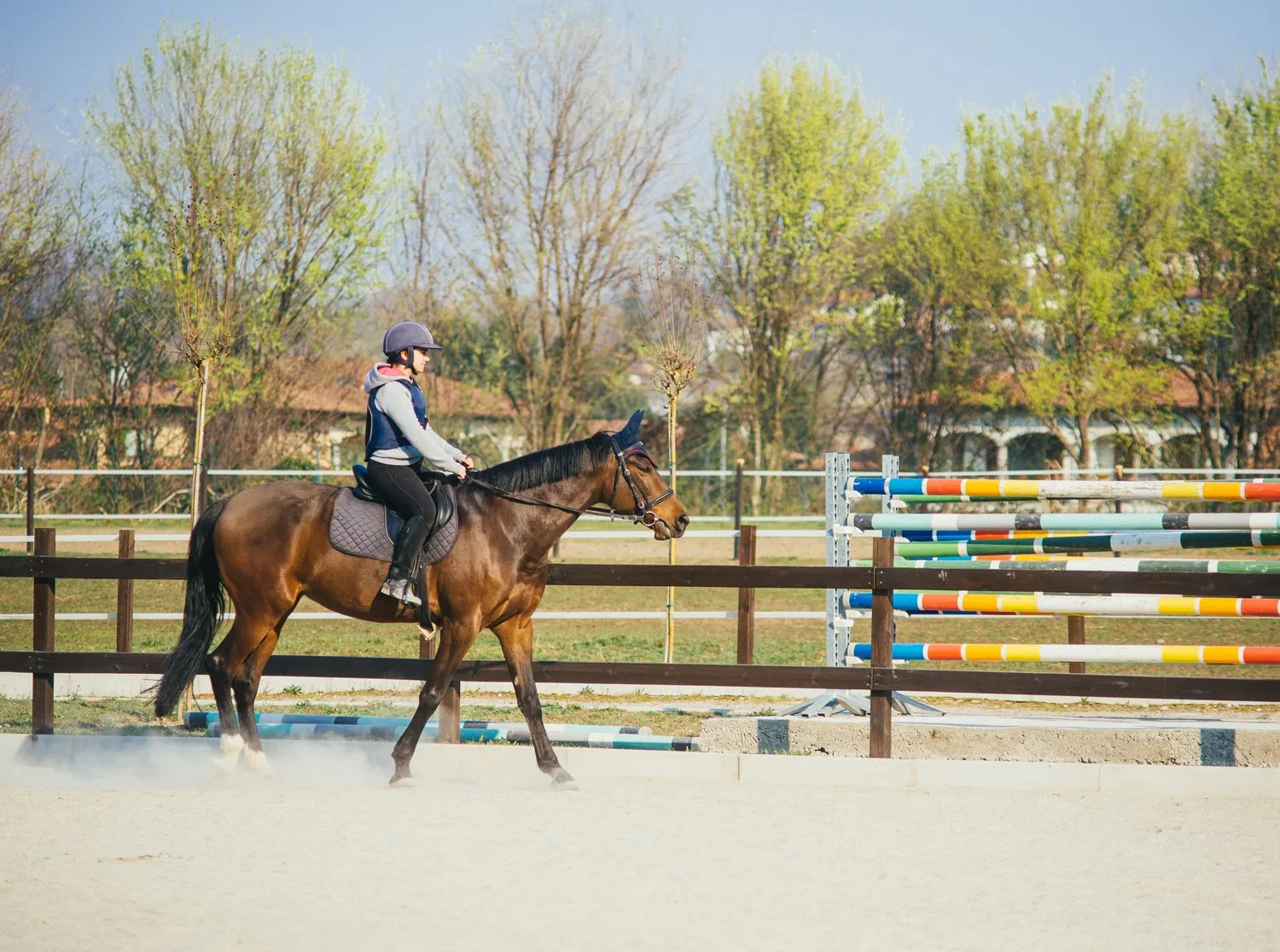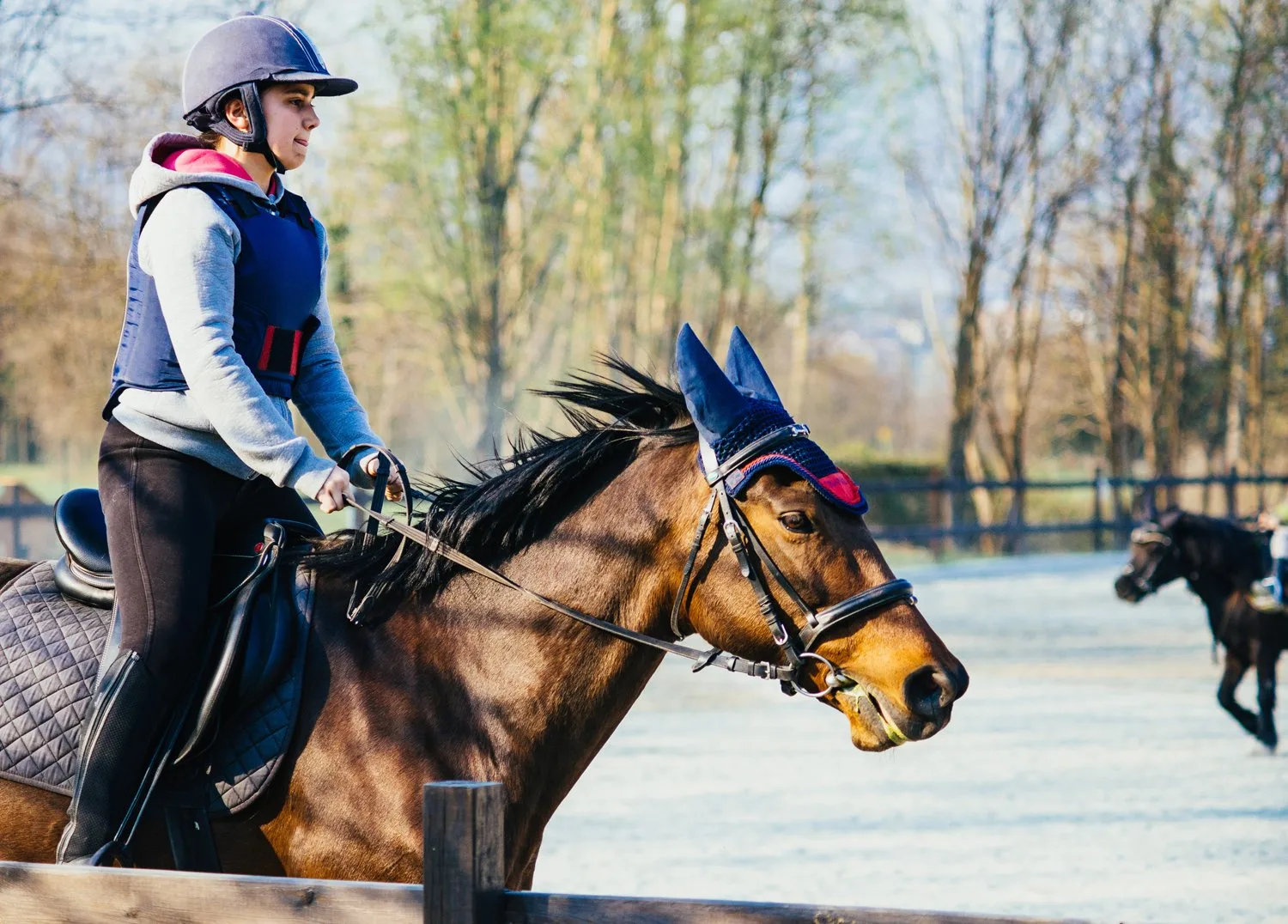The idea of riding a horse for the first time is, for many people, equal parts thrilling and intimidating! Horseback riding is a less and less common hobby as the world modernizes, but there is something about this activity that continues to draw us.
In this article, you’ll learn what to expect your first time riding a horse.
- Because there are a few different ways to encounter your first experience horseback riding, I will approach this topic from a couple different directions. You’ll learn what to expect from:
- your first time riding a horse in a riding lesson,
- your first time riding a horse while visiting a horse farm or riding a friend’s horse,
- and you’ll learn how to prepare for riding a horse for the first time on vacation.
- You’ll learn a crash course in what to wear horseback riding! Don’t worry, I’ve got you – and all your horseback riding eventualities, covered in my article on what to wear horseback riding)
- we’ll cover some basic expectations, to help reduce anxiety before and during your first ride,
- and finally, you’ll learn some essentials of horseback riding etiquette that are important to know for your first time.
What won’t be covered in this guide: it’s safe to assume that where ever you take your first horseback ride, someone will be with you to show you the ropes. Because of this, what you won’t find in this article is instructions for mounting, holding the reins, stopping and turning horses, and similar instructions for actual horseback riding. Also, we won’t cover basic horse terms, although you can read my article about keywords to know before your first ride.

Things you can Expect for Your First Horseback Ride:
1. Expect that your horse will be slow
When you are riding a horse for the very first time, it’s actually a very good thing if your horse is very slow. Slow horses are safe horses. If you lose your balance you’ll have a better chance of regaining it if your horse is slow and unflappable.
If the person supporting you on your first ride is a responsible horse owner they will pair you with a laid-back course that naturally moves a little slower. It probably won’t be the prettiest horse in the stable, but these are the best horses to learn with. (In horseman’s terms, they’re called “bombproof horses,” though that’s a bit of a misnomer)
And no, you won’t be galloping across the beach or cantering through a field on your first time horseback riding.
Set aside visions of cantering or galloping on your first ride. Riding a canter is an intermediate riding skill, and galloping is best left to advanced riders. (Wondering how long it will take you to learn to ride? Click here for a basic guide to how long it takes to learn to ride horses)
2. Expect to Feel Very Wobbly
For the first five or 10 minutes of your first time horseback riding, you’ll probably feel very wobbly. In those first few minutes brains and bodies are rapidly working to figure out how to move naturally while still staying centered in the saddle.
As someone who has helped many riders through their first time riding a horse, it’s incredible how quickly our bodies learn to balance on horseback. While you won’t be ready to trot your horse over jumps anytime soon, you will be amazed I how much more stable you’ll feel in the saddle after just 15 or 20 minutes.
3. Expect to be Supported
Your first time in the saddle should be a gentle and positive experience. Most riding instructors, trail riding guides, or horse owners understand this. You should not be asked to do anything you are not ready or comfortable doing.
For example, if you’re on a trail ride that splits up and allows some riders to go faster, you should have an option (as a first time horseback rider) to stay at a walk with a guide and rejoin your group later.
You might be frustrated by the boundaries you get, though. Many riding instructors conduct a first riding lesson on something called a lunge line. In this type of riding, the horse has a very long lead held by the instructor. The horse circles the instructor in a large circle, allowing a rider to focus on their balance instead of controlling the speed and direction of the horse. For some people, riding for the first time on a lunge line can be a disappointing experience. In my experience, though, it’s a sign that you have found a good riding instructor willing to slow down and teach the basics.
4. Expect (the Actual Riding) to be a Pain-Free Experience
Horseback riding should be a pain-free experience. If something hurts during your first time horseback riding, it’s a sign that something is wrong. If you experience pain around your groin, knees, or even lower back, these signal that either your position or your saddle is at fault.
If you experience pain while riding, let your host know. The issue may be as simple as stirrups buckled at the wrong lengths or a saddle sized incorrectly for your body.
Pro tip: saddle sores happen, but with some preventative strategies, they shouldn’t be an issue. To avoid them, it’s best to wear seamless underwear and opt for sweats or leggings instead of jeans with bulky seams.
5. Expect to be a Little Sore the Next Day
If your expectations for how sore you will be after your first time horseback riding is based on comedy skits, you’ll probably be pleasantly surprised! A brief ride at a walk probably won’t leave you in agony.
Horseback riding makes us sore because it intensely stretches muscles along the groin and inner leg. These muscles will get more of a workout the longer you are in the saddle, and the more actively you ride. In other words, if you’re in a lesson with an instructor who is helping you work on your balance and position, you’ll be more sore than if you were a a passive rider on a pony ride type experience.
Thankfully, there are ways to minimize muscle soreness, in fact, I wrote a whole article about it! Here is the tl;dr: stretch before you ride, stretch after you ride, and take a over-the-counter pain medication as needed.
6. Nerves are Normal!
In my tenure as a riding coach, and with my background with a Masters in psychology, one thing I have noticed is that people experience less anticipation anxiety when they know what to expect from a new experience.
In the case of your first time horseback riding, you’ve got a few firsts happening all at once:
- you’re trying a new sport,
- you’re getting familiar with a very large animal,
- and you’ll be putting a lot of trust in that animal.
Horseback riding well requires trust, balance, and practice. It’s unlike any other sport because you’ll be working in relationship with an animal. Thankfully, the horses that are chosen for first time riders are usually the very best horses on a farm.
Safety Advice: before your first time horseback riding, confirm your expectations for a great experience. Read the reviews of the riding stable you are visiting, check out other travelers’ reports on the beach riding excursion from your cruise ship, or take an honest look at your relationship with the person who invited you to their farm to ride. In order for your first experience riding to be safe, you need to trust the organizer of the ride to be skilled, knowledgeable, and responsible enough to put you on a safe horse with a temperament that’s appropriate for a first-time horseback rider.
Base Your Expectations on Where you are Riding
The type of horseback riding experience you signed up for will definitely shape reasonable expectations. To illustrate, here’s what you can expect from typical places to ride a horse for the first time:
Riding lessons
As a riding coach, I’m biased, however I firmly believe that a riding lesson is the best and safest way to ride a horse for the first time. In a good riding stable, with a riding coach, on a safe lesson horse you can focus on the experience. A riding lesson will provide you with a safe horse, teach you the basics of handling a horse, and make sure that your first time riding a horse is positive.
💡 Take a Riding Lesson to Prepare for Vacation Riding
Hint: if you’re feeling a little anxious about your first time horseback riding happening on a honeymoon or international vacation, and you’d like to build confidence first, try booking a riding lesson back home before leaving for your trip. A lesson or two in the confines of a safe riding arena will help you have more fun during your destination horseback riding experience.
Riding with a Friend
Where I grew up, in rural Kansas, everyone’s first time horseback riding is when a friend or extended family member invites you over, plops you on a horse that may or may not be beginner appropriate, and you proceed to figure out the details while navigating around maneuver piles, roadside ditches, and barbed wire fences. Although my experience is certainly colorful, many people have different experiences riding horses for the first time at a friend’s farm.
Because this type of first horseback ride can vary so much, it’s hard to predict what your expectations should be. The best way to set expectations for riding a friend’s horse or visiting the farm of someone you know is to consider the type of person who has invited you. Are they a kind, responsible, and empathic person? If so, you can expect that responsibility and empathy to translate to your riding experience. If their personality edges on risk-taking, confrontation, or struggling with empathy, these might be signs that it might be appropriate to set boundaries regarding your visit to their farm (such as only mounting up if you feel very confident in the horse that they’ve partnered you with)

Horseback Riding for the First Time While on Vacation
Many people who have never ridden a horse before take their first ride while on vacation. In fact, my favorite beachfront Mexican resort is visited each morning by a man on horseback with two horses in tow! Whether it’s an impromptu ride on a beach, cruise ship excursion, or an organized trail ride, here’s what you can expect from riding horses on vacation:
Generally, these horses are very experienced and very docile (and realistically, sometimes very tired or underfed, which affects their energy level).
The biggest expectation versus reality letdown for most people riding horses on vacation include the following:
- Unless you are an experienced rider, you probably won’t be allowed to gallop
- Despite dreams of bareback riding horses on the beach, you will almost certainly be required to use a saddle (and without a saddle, you will almost certainly fall off your first time horseback riding!)
- You probably will not get to wade in the surf with your horse while riding on the beach as part of a tropical holiday or cruiseship excursion. Saltwater is corrosive to horse equipment, and horses can act unpredictably in water, so it is likely that your guide will require that you stay well away from the water.
- Horseback riding on beaches has a minor negative ecological impact.1 Because of this, in some locations, you may not be allowed on the actual beach. Some destinations allow riding on the beach, or certain parts of the beach, while others forbid it completely.
Horseback riding on vacation can be an amazing part of an unforgettable vacation, but it’s best to set appropriate expectations for the experience. For more information on how to pack for a great experience riding horses on vacation, check out my article all about riding horses on the beach.
What to Wear for your First Horseback Ride
Don’t worry, no one will expect you to have a full riding outfit for your first ride! In nearly all cases, your host will even supply a helmet for you. Here’s what your riding outfit should include, at the very basic:
- Close-toed shoes with a bit of a heel. If you’ve got a pair of sturdy Chelsea boots or Blundstones, those will be perfect!
- Soft, stretchy pants with no bulky seams. Leggings or fitted sweatpants are perfect, just be sure there aren’t bulky seams that could chafe.
- Sunscreen. Horseback riding is a sport that elevates the risk of sun-related skin damage.2 Be sure to wear sunscreen for your first experience horseback riding.
For a complete guide to getting dressed to ride, check out my Ultimate Guide to What to Wear Horseback Riding.
Stable Etiquette for First-Time Riders
Your host, guide, or riding instruction will teach you everything you need to know for a successful first ride, but here are a few basic truths to keep in mind:
- Don’t walk behind a horse unless instructed how to.
- Never feed treats to a horse without permission.
- Avoid sudden movements. Some horses spook easily.
- Horses can’t see directly in front or directly behind them. Avoid these areas.
- Take instructions seriously. Horses are large animals!
Final Advice
It can be hard to know what to expect from our first time horseback riding, but I hope this article has given you the confidence to find out for yourself. Remember, trust your judgment about the person you are riding with and get to know your horse a bit before mounting up. Your first riding experience should be a positive entry into the incredible world of horses.
- Newsome, D., Smith, A., & Moore, S. A. (2008). Horse riding in protected areas: a critical review and implications for research and management. Current Issues in Tourism, 11(2), 144-166. [↩]
- Epstein, J. H., & Silverman, R. A. (1987). Blocking ultraviolet damage to the skin. Patient Care, 21, 26-39. [↩]

